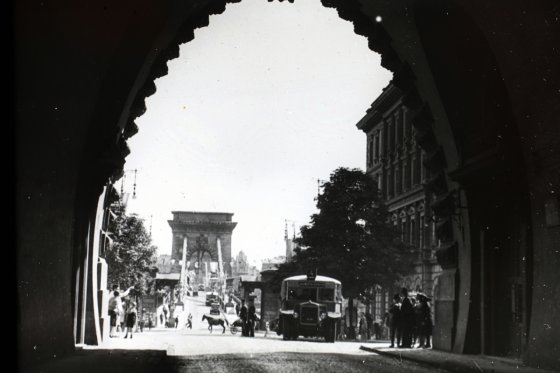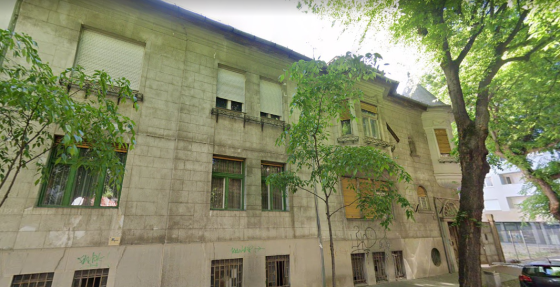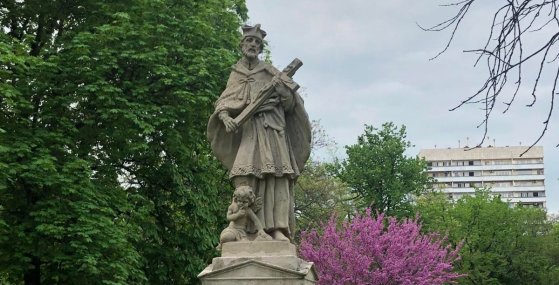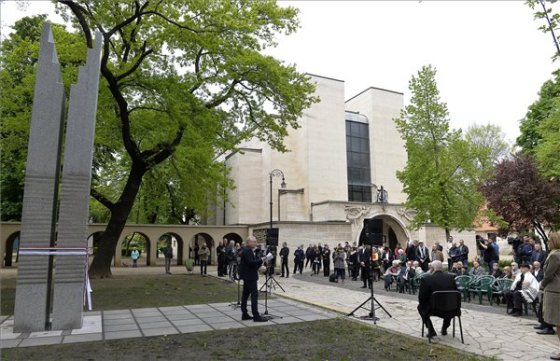 The „intertwined history” of the bridges and the city of Budapest
Which ideas and events have shaped the fate of bridges of Budapest and the cityscape? Alongside many other interesting facts, this question is also answered this newly published book by the Budapest City Archives, which introduces the history of bridges in Budapest.
The „intertwined history” of the bridges and the city of Budapest
Which ideas and events have shaped the fate of bridges of Budapest and the cityscape? Alongside many other interesting facts, this question is also answered this newly published book by the Budapest City Archives, which introduces the history of bridges in Budapest.
PestBuda
 Károlyi Sándor Hospital will be expanded with a new wing, the main building will also be renovated
Károlyi Sándor Hospital will be expanded with a new wing, the main building will also be renovated
May 11, 2022 at 9:00 PM
The Károlyi Sándor Hospital in Újpest will be expanded with a new part of the building. In addition to the construction of the new seven-storey wing, the main building of the hospital, designed by Miklós Ybl, will also be renovated, but a building deemed dangerous will also be demolished in the area.
A medieval cellar was found on the outskirts of Budapest
May 10, 2022 at 2:00 PM
On the border of Budakalász and the Barát stream, in addition to several prehistoric finds, the remains of a medieval cellar have also been found. The cellar may have belonged to the medieval village of Kissing, and probably dates back to the 13th century.
We can count on paramedics in Budapest for 135 years - The first ambulances were still drawn by horses
May 10, 2022 at 9:00 AM
We can count on the help of paramedics in Budapest for 135 years now. The Budapest Volunteer Ambulance Association started its operation on 10 May 1887 in today's Szent István Square, but soon after, they were able to move into their new headquarters on Markó Street. The paramedics initially rode in horse-drawn carriages, but in 1902, 120 years ago, they already rushed in an electric car to help those in trouble.
Colourful memento about a brilliant architect - The Postal Palace became the main work of Gyula Sándy
May 8, 2022 at 12:00 PM
Finding and viewing pieces of the architectural heritage of a city with a long history is an eternal tourist hit. Budapest stands out in this area mostly with the legacy of dualism and the two world wars: almost everyone have encountered the names of Miklós Ybl, Imre Steindl or Ödön Lechner, but if we dig deeper, it is impossible to list how many undeservedly lesser-known talents contributed to the decoration of the Hungarian capital. The building of the Buda Postal Palace, which adorns the south-western side of Széll Kálmán Square, is also connected to such a genius: a remarkable volume came out this year about Gyula Sándy's life and work, both from a professional and a layman's point of view.
The first Zero Kilometre Stone was placed in Clark Ádám Square 90 years ago
May 7, 2022 at 10:00 AM
All roads lead to the Chain Bridge. This saying is true in that the length of the main roads starting from Budapest is calculated in kilometres from here, the Chain Bridge, more precisely from Clark Ádám Square on the Buda side. To mark this, the first 0-kilometre stone was inaugurated here on 7 May 1932, 90 years ago.
The restored Immaculata statue in Krisztinaváros is back to its place - its original was erected 320 years ago
May 6, 2022 at 8:00 PM
Another sculpture with a long history was renewed in the capital: the Immaculata statue in Krisztinaváros, erected 320 years ago in 1702 - the oldest public sculpture in Budapest - has been replaced by a copy since 1928, and in the meantime this work has also needed to be restored. The work was carried out at the Department of Restoration of the Hungarian University of Fine Arts recently, and yesterday the sculpture was placed at the Krisztina Square erection site.
The last element of the Southern Connecting Railway Bridge was replaced
May 6, 2022 at 5:30 PM
The third structure of the new connecting railway bridge is now passable, as its last piece has been replaced. The rail and other works will then be carried out and the trial load is expected to take place in early August. This marked another milestone in the development of the Southern Circuit, which aims to increase the utilization of suburban trains, thereby reducing car traffic in the capital.
From tomorrow, the nostalgia trams will run again
May 6, 2022 at 2:30 PM
The image of Budapest includes the old trams. From Saturday there will be nostalgic trams again, the vehicles will run between the city center and Óbuda.
The statue of Ferenc Rákóczi II was unveiled in Kossuth Square 85 years ago
May 5, 2022 at 11:00 AM
The statue of Ferenc Rákóczi II has been standing on Kossuth Square for 85 years now. Its erection was decided on the 200th anniversary of his death, and two years later, in 1937, the statue stood. Since then, only the inscriptions have been changed, sometimes for political or grammatical reasons.
The previously felled trees were replaced in Benczúr Street in Terézváros
May 3, 2022 at 7:00 PM
Instead of the 29 trees previously felled, 36 new ones were planted in the 6th district Benczúr street, and the size of the wood places was also increased. The 36 new trees were planted by experts from Főkert.
Budapest was enriched with new monuments
May 3, 2022 at 2:00 PM
A 13th district real estate and a 21st district complex was declared a monument, thus further expanding the list of monuments in the capital. In addition to a number of rural properties published in the Hungarian Gazette last Friday, the service buildings of the residential building at 20 Kartács Street and the Kvassay Lock adjacent to the Kvassay Bridge received monument protection.
We have been able to fly abroad from Budapest as a passenger for a hundred years
May 3, 2022 at 11:00 AM
Today, we take it for granted to buy a plane ticket and simply get on the plane. Few think about since when we can do this. And now we are celebrating an anniversary: our predecessors were first able to board a passenger plane in Budapest 100 years ago. Since then, the industry and tourism have also undergone tremendous development: almost 16 million passengers turned up at Liszt Ferenc Airport in the year before the epidemic.
Two more of Molnár-C. Paul’s work can be found in the downtown parish church
May 2, 2022 at 6:00 PM
Two more of Molnár-C. Paul's two more paintings were placed in the Budapest-Downtown Parish Church on Thursday. Earlier, he also made the crucifix hanging above the sanctuary and the main altarpiece, as they were destroyed in World War II.
Before the big changes - Budapest at the time of the compromise
May 2, 2022 at 11:00 AM
The Austro-Hungarian Compromise, established in 1867, ushered in one of Hungary's heyday. Under the Compromise of 155 years ago, a dual system was created - hence our common word dualism, which is used to characterise the period up to 1918. This upswing has brought about great changes: as a result of industrialisation, more and more people have moved to the cities, and the population of Budapest has grown exponentially. But what was the capital like in the second half of the 1860s?
With a balloon over Budapest - the Turul took off 120 years ago
May 1, 2022 at 10:00 AM
The hot air balloon lookout opened in Városliget is not the first such contraption in Budapest: it was already possible to rise above the city with a balloon at the millennium exhibition. However, the balloon, Turul, launched 120 years ago on 1 May 1902, was not intended to entertain the public, but to do research. In addition to meteorological observations,we can also thank it for a number of aerial photographs, which show how Budapest looked from above at the beginning of the 20th century.
The statue of St. John of Nepomuk in Krisztinaváros is being restored
April 30, 2022 at 4:00 PM
The statue of St. John of Nepomuk in the Horváth Garden is being renovated. The original of the work dates back to the 19th century. It preserved the banks of the Devil's Trench from the first half of the 19th century, but the old, damaged statue was demolished in the 1960s, and in 1999 the statue, which can still be seen today, was completed and restored.
The first official program was broadcast by Hungarian Television 65 years ago
April 30, 2022 at 9:00 AM
Television is nearly a hundred-year-old invention that many Hungarian researchers worked on in the beginning. In Hungary, however, work began only in the 1950s to enable Hungarian broadcasting in Hungarian households. The experimental broadcasts started in 1956, and after the revolution, on the evening of 26 April 1957, a film was shown on television, but the first "official" broadcast, the Heroes' Square parade, was broadcast by the Hungarian Television only on 1 May 1957, for political reasons.
This will be the Town Hall Park - The results of the design competition have been announced
April 29, 2022 at 3:00 PM
Next year, the renovation of the area on the Károly boulevard side of the Central Town Hall, which was used as a car park, may begin. The results of last year’s design competition were announced today, with the winning plan to preserve the existing trees in an area of about 8,000 square meters, next to which new ones will be planted, a number of new benches will be erected and there will also be bumps. The renovation of Town Hall Park is expected to be completed by 2024.
A monument was inaugurated for World War II victims in the 12th district
April 28, 2022 at 9:00 PM
On Thursday, in the park area in front of the Church of the Heart of Jesus in Városmajor, a memorial to the civilian and military victims of world war II was handed over. The monument, which consists of two granite blocks, depicts in an abstract way the loss that extinguished human lives have meant and will mean to those affected.
Archaeologists may have found a medieval cemetery in the 11th district
April 28, 2022 at 2:00 PM
Among the prehistoric traces, the staff of the Budapest History Museum presumably found medieval burials next to Budafoki street in Újbuda. Traces of Stone Age finds and buildings have been found in the area before, now the former cemetery of the village of Kocsola, which was destroyed in the Middle Ages, has probably been found.
The equestrian statue of András Hadik was unveiled in the Buda Castle 85 years ago
April 28, 2022 at 9:00 AM
The work of the sculptor György Vastagh Jr., who also made the Csikós statue, was unveiled in 1937 in the small square at the intersection of Úri Street and Szentháromság Street in the presence of the country's leaders at the time. The statue commemorating the former warlord of the Habsburg Empire, András Hadik and the 3rd Hussar Regiment, has been associated with a strange custom among graduating students of the Műegyetem (Budapest University of Technology) since the 1950s.
New city center is being built in Zugló - Renewal of Bosnian Square and its surroundings may begin soon
April 26, 2022 at 4:00 PM
Renovation of Bosnyák Square, intended as the main square of the 14th district, may begin soon. It is planned that not only a new town hall, specialist clinic and fair hall will be built, but also a completely new quarter, and the affected section of the Rákos stream will be rehabilitated. The investment, previously declared a priority, has now received a building permit.
Bees on the roof - The inner hall of the Postal Savings Bank is being renovated
April 25, 2022 at 9:00 AM
In the vicinity of Szabadság Square, the Postatakarékpénztár [Postal Savings Bank], which was built at the turn of the century, has been being renovated for months. In addition to Ödön Lechner's main work, three other works by the master are also being restored: the Museum of Applied Arts, the Balás Sipeki Villa next to the Városliget and the Drechsler Palace on Andrássy Avenue. While the latter are undergoing a larger-scale change visible from the outside, in the case of the Postal Savings Bank, its internal box office will get back its original dome. Once upon a time, this was also characterized by an imaginative ornamentation similar to the façade, but it was remodelled over time according to the needs of its use, but it was not spared by the storms of history.
The garden of revolution and love - A Museum Garden Guide from a new angle
April 24, 2022 at 7:00 PM
One of the most charming open-air venues in the city centre is the Museum Garden, which once again shines in its full splendour: looking at its sculptures and memorial plaques, or relaxing on one of the museum’s steps and benches, can reminds us of the rich past of this special historical site. This extraordinary richness is illustrated by a gap-filling publication, the Museum Garden Guide, which - worthy of its title - guides us through the garden, recalling the events of the past, with many surprises in store for the reader.
The Törőcsik Mari Park in Újbuda was inaugurated
April 24, 2022 at 10:30 AM
On Thursday, the Törőcsik Mari park was inaugurated in the 11th district. The hitherto unnamed parkland at Bottomless Lake now bears the name of the legendary actress.
Sixty years ago, Budapest was at a crossroads - the transport of the capital in the 1960s
April 23, 2022 at 2:00 PM
Budapest's traffic was at a crossroads 60 years ago as well as now. Experts sought answers to questions about how much the then outdated public transport network needs to be developed and how to prepare the city for the expected car traffic. Studies have also helped to make these decisions. Based on a work published 60 years ago, we present the transport dilemmas of Budapest at that time.
The monumental building on Károly boulevard will soon receive its ornate domes back
April 22, 2022 at 5:00 PM
The imposing roof of the Art Nouveau apartment building at 3 / A Károly boulevard will be rebuilt soon. The roof of the house, built after the turn of the century, was damaged in World War II and was later restored in a simplified manner. The roof reconstruction of the building, which is now home to the Downtown Theater, was made a priority investment by a government decree issued last week.
Another four green bus waiters have been set up in Downtown
April 22, 2022 at 2:00 PM
The number of bus waiters planted and planted with plants in the city center has further expanded. The green waiting places have been handed over in Hild Square, Servita Square, Podmaniczky Square and Jászai Mari Square, so there are now eight green bus waiting areas in the city center.
A world-famous Hungarian brand - The Törley Champagne Factory is 140 years old
April 22, 2022 at 9:00 AM
To this day, Törley champagne is one of the most famous Hungarian products, an almost obligatory element of the celebrations in Hungary, and the brand is also present in many foreign countries. Like almost everything, the roots of this factory date back to the second half of the 19th century, the period of dualism: József Törley founded his plant in Budafok in 1882, exactly one hundred and forty years ago. However, not only the drink made there is of a very high standard, but also the family's buildings in Budapest.
Educational institution from asylum - The transformation of the former mental hospital in Lipótmező is about to begin
April 21, 2022 at 3:00 PM
The Lipótmező mental hospital was once considered one of the best psychiatric institutes in the country. The institution, officially called the National Institute of Psychiatry and Neurology, was closed in 2007. It was decided two years ago that an educational institution would be built in the huge building complex. The associated remodeling and refurbishment work will begin soon as the development was declared a priority investment by the government on Tuesday.
More articles
 The „intertwined history” of the bridges and the city of Budapest
Which ideas and events have shaped the fate of bridges of Budapest and the cityscape? Alongside many other interesting facts, this question is also answered this newly published book by the Budapest City Archives, which introduces the history of bridges in Budapest.
The „intertwined history” of the bridges and the city of Budapest
Which ideas and events have shaped the fate of bridges of Budapest and the cityscape? Alongside many other interesting facts, this question is also answered this newly published book by the Budapest City Archives, which introduces the history of bridges in Budapest.
 The Bridge Report, which brought a turning point in the history of Budapest
A travel report that changed the history of Pest and Buda, as well as Hungary. The little book contributed to the change of half a thousand years of legal customs and the implementation of an investment of unprecedented size and technical quality. This book was The Bridge Report [Hídjelentés in Hungarian].
The Bridge Report, which brought a turning point in the history of Budapest
A travel report that changed the history of Pest and Buda, as well as Hungary. The little book contributed to the change of half a thousand years of legal customs and the implementation of an investment of unprecedented size and technical quality. This book was The Bridge Report [Hídjelentés in Hungarian].
 Drama on the university wall - The heroic monument was planned 95 years ago
In the constant hustle and bustle of the Egyetem Square in Pest, the students may not even notice the monument that decorates the short section of wall between the church and the central building of ELTE. However, it commemorates their predecessors, the heroes who fought for their country in World War I, and those who heroically helped them. The first design of the dramatically collapsing soldier was born in 1928, ninety-five years ago.
Drama on the university wall - The heroic monument was planned 95 years ago
In the constant hustle and bustle of the Egyetem Square in Pest, the students may not even notice the monument that decorates the short section of wall between the church and the central building of ELTE. However, it commemorates their predecessors, the heroes who fought for their country in World War I, and those who heroically helped them. The first design of the dramatically collapsing soldier was born in 1928, ninety-five years ago.





























